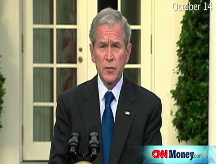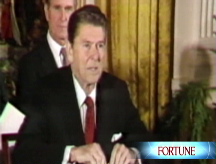U.S. pulls the trigger
Government to pump billions into banks, expand deposit and loan guarantees.
NEW YORK (CNNMoney.com) -- The federal government on Tuesday announced an extraordinary and historic direct investment in the nation's banks - the biggest bet ever made with taxpayer dollars on the U.S. financial system.
As a start, the Treasury will pump $250 billion into financial institutions. Nine of the nation's largest banks have already agreed to take the capital and in return will give preferred shares to taxpayers and accept limits on executive pay. Half of the money, or $125 billion, will go to the nine large banks.
"This is an essential short-term measure to assure the viability of America's banking system," President Bush said in comments outside the White House. "These measures are not intended to take over the free market, but to preserve it."
In addition, Bush made a formal request for an additional $100 billion to help out financial institutions. Congress authorized up to $700 billion as part of the financial system bailout enacted on Oct. 3, but it required the president to certify the need for any amount above the initial $250 billion.
The government can use the additional $100 billion to buy troubled assets held by firms or to make additional capital infusions into banks.
The President also announced insurance on all deposits in non-interest bearing bank accounts, a move that should calm businesses worried because their payroll and checking accounts may exceed the limits backed by the Federal Deposit Insurance Corp. And the government will also back most new bank debt - a change designed to spur more lending between banks.
The package represents the government's most extensive attempt yet to unfreeze frozen credit markets. The aim is to give banks the confidence to make loans to one another and their customers and help provide the economy the source of funds it needs to operate.
The move was something that the Bush administration and Treasury Secretary Henry Paulson resisted even as the crisis in the nation's financial system mounted over the last month.
"Government owning a stake in any private U.S. company is objectionable to most Americans - me included," Paulson said. "Yet the alternative of leaving businesses and consumers without access to financing is totally unacceptable."
The nine financial institutions that will split that first pool of money include the nation's four largest commercial banks - Bank of America (BAC, Fortune 500), Citigroup (C, Fortune 500), JPMorgan Chase (JPM, Fortune 500) and Wells Fargo (WFC, Fortune 500).
Also included are the two remaining independent investment banks - Goldman Sachs (GS, Fortune 500) and Morgan Stanley (MS, Fortune 500) - as well as Merrill Lynch (MER, Fortune 500), which last month agreed to sell itself to Bank of America. Two other major banks that primarily serve Wall Street rather than retail customers, Bank of New York Mellon (BK, Fortune 500) and State Street Corp. (STT, Fortune 500) round out the nine institutions getting help in this first round of investments.
Most of those firms' stock prices were sharply higher in late morning trading. The only exception was JPMorgan Chase, which was off by 4%.
The plan generally found support among economists and experts, including many who had been critical of an earlier plan to simply buy mortgage-backed securities held by banks and Wall Street firms that had been hurt by falling home prices and rising mortgage defaults.
"This is finally the comprehensive and detailed plan that the market has been looking for," said Jaret Seiberg, financial institution analyst for the Stanford Group. "It addresses the biggest problem that banks face, which is a capital crunch, and it attempts to fix the short-term debt markets, plus it reduces the risk of liquidity runs on banks. That's a pretty powerful first punch."
But Seiberg cautioned that the problems in the economy, and tighter credit for many consumers, won't disappear overnight. "The credit market has been broken for many weeks now, and it's not going to snap back overnight," he said.
The previously announced plan to buy mortgage assets from banks and Wall Street firms had done little to assure investors or get financial institutions providing the loans necessary to keep the U.S. economy functioning.
U.S. stocks had their worst week in history last week, and most measures showed lending by financial institutions remained frozen despite moves by the Federal Reserve to pump potentially trillions of new dollars into the system.
So over the weekend, the administration decided to use the authority under the $700 billion Wall Street bailout package passed earlier this month to make the direct investment. The moves followed a similar plan announced last week in Great Britain. European governments had been moving the same way.
On Tuesday, Bush acknowledged that the United States was following steps already taken in Europe. He said that is the best way to address the concerns of U.S. consumers and business leaders.
"I recognize that the action leaders are taking here in Washington and European capitals are distant from those concerns, but they are designed to benefit the American people by stabilizing the overall financial system and helping the economy recover," Bush said.
The reports of the broad details of the plan had sparked the biggest jump in stocks in history on Monday, and that rally continued in Asian and European markets early Tuesday. U.S. stocks moved sharply higher in early trading following the announcement, but then gave up their gains and were narrowly lower before recovering again in late-morning trading.
After Bush's announcement, Paulson, Federal Reserve Chairman Ben Bernanke and FDIC Chairman Sheila Bair made a joint appearance to endorse the plan.
"Today, there is a lack of confidence in our financial system - a lack of confidence that must be conquered because it poses an enormous threat to our economy," Paulson said. "Investors are unwilling to lend to banks, and healthy banks are unwilling to lend to each other and to consumers and businesses."
Paulson stressed that some of the banks accepting government investment are healthy, but that the infusion of capital will allow them to increase their lending.
For his part, Bernanke said these steps were notable because the government is not waiting for banks to become insolvent before they act.
"Waiting too long to act has usually led to much greater direct costs of the intervention itself and, more importantly, magnified the painful effects of financial turmoil on households and businesses," Bernanke said in prepared remarks.
And Bernanke cautioned that while he was confident the plan is the best course to follow to get the economy functioning again, it does not automatically end the troubles facing the economy.
"I am not suggesting the way forward will be easy," Bernanke said.
Bair said that the United States had to follow steps taken in Europe or else they would have been on an uneven playing field. And regulators' work is not done, she added.
"All of us are prepared to do whatever it takes to fix whatever problems arise and to work with Wall Street and Main Street to unclog the financial system," said Bair. ![]()






